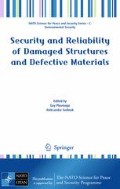Abstract
The development, definition and implementation of crack parameters (stress intensity factor, crack tip open displacement, J integral, final stretch zone) are presented. They are now used for structural integrity and residual life assessment and fracture analysis of cracked components in elastic and plastic range, what is illustrated by typical examples.
Access this chapter
Tax calculation will be finalised at checkout
Purchases are for personal use only
Preview
Unable to display preview. Download preview PDF.
References
R. W. Nichols, The Use of Fracture Mechanics as an Engineering Tool, The 1984 ICF Honour Lecture. Sixth International Conference on Fracture, ICF 6, New Delhi, India, 1983.
A. A. Griffith, The phenomena of ruptures and flow in solids. Phil. Trans. R. Soc. London. A, 221: 163–198, 1920.
C. E. Inglis, Stresses in a plate due to the presence of cracks and sharp corners. Proc. Inst. Naval Arch. 55: 219–241, 1913.
G. Kirsch, Die Theorie der Elastizität und die Bedürfnisse der Festigkeitslehre. (Theory of elasticity and needs of strength of materials), Zeitshrift des Vereines deutscher Ingenieure, 42, 797–807, 1898.
J. F. Knott, Fundamentals of Fracture Mechanics, London: Butterworths, 1973.
ASTM E399-87, Standard Test Method for Plane-Strain Fracture Toughness of Metallic Materials, Annual Book of ASTM Standards, Vol. 04.01. p. 522. 1986.
T. L. Anderson, Fracture Mechanics, CRC, Taylor & Francis Group, LLC, 2005.
S. Sedmak, Z. Burzic, Fracture Mechanics Standard Testing, From Fracture Mechanics to Structural Integrity Assessment, IFMASS 8 Monograph, pp. 95–122, TMF — DIVK, Belgrade, 2004.
A. A. Wells, Application of fracture mechanics at and beyond general yielding. Br. Welding J. 11: 563–570, 1963.
G. R. Irwin, Plastic Zone Near a Crack and Fracture Toughness. Proceedings of Seventh Sagamore Research Conference on Mechanics and Metals Behavior of Sheet Material. Vol. 4, 463–478, Racquette Lake, NY, 1960.
D. S. Dugdale, Yielding of steel sheets containing slits. J. Mech. Phys. Solids. 8: 100– 104, 1960.
K. Gerić, Merenje kritične zone razvlačenja. (Measurement of final stretch zone). Eksperimentalne i numeričke metode mehanike loma u oceni integriteta konstrukcija IFMASS 7, pp. 271–279, TMF-JSZ-GOŠA, 2000.
H. Tada, P. C. Paris, G. R. Irwin, The Stress Analysis of Crack Handbook. Del Research Corporation, Hellertown, PA, 1973.
A. Sedmak, Primena mehanike loma na integritet konstrukcija. (The Use of Fracture Mechanics in Structural Integrity), Mašinski fakultet, Beograd, 2003.
K. Gerić, Prsline u zavarenim spojevima (Cracks in welded joints). FTN Izdavaštvo, Novi Sad, 2005.
British Standard BS7910 Guide on Methods for Assessing the Acceptability of flaws in Fusion Welded Structures, 1999.
Structural INTegrity Assessment Procedures for European Industry (SINTAP Procedure), BRITE European project, Final version: November 1999.
M. M. Ratwani, F. Erdogan, G. R. Irwin, Fracture Propagation in Cylindrical Shell Containing an Initial Flaw, Lehigh University, Bethlehem, 1974.
R. B. King, Elastic-plastic analysis of surface flaws using a simplified line-spring model. Eng. Fract. Mech. 18: 217–231, 1983.
S. Sedmak, A. Sedmak, Welded penstock, produced of high strength steel and application of fracture mechanics parameters to structural integrity assessment. G. Pluvinage and M.H. Elwany (eds.) ARW NATO Safety, Reliability and Risks Associated with Water, Oil and Gas Pipelines, Springer Verlag, pp. 271–286, 2008.
S. Sedmak, B. Petrovski, A. Sedmak, Z. Lukačević, The study of crack significance in spherical storage tanks by J resistance curve, International Conference on Weld Failures, TWI, Welding Institute, London, 1988.
A. Sedmak, S. Sedmak, Critical crack assessment procedure for high pressure steam turbine rotors. Fatigue Fract. Eng. Mater. Struct., 18(9): 923–934, 1995.
Author information
Authors and Affiliations
Editor information
Editors and Affiliations
Rights and permissions
Copyright information
© 2009 Springer Science + Business Media B.V.
About this paper
Cite this paper
Sedmak, A., Milović, L., Lozanović, J. (2009). Development and Application of Crack Parameters. In: Pluvinage, G., Sedmak, A. (eds) Security and Reliability of Damaged Structures and Defective Materials. NATO Science for Peace and Security Series C: Environmental Security. Springer, Dordrecht. https://doi.org/10.1007/978-90-481-2792-4_9
Download citation
DOI: https://doi.org/10.1007/978-90-481-2792-4_9
Publisher Name: Springer, Dordrecht
Print ISBN: 978-90-481-2791-7
Online ISBN: 978-90-481-2792-4
eBook Packages: EngineeringEngineering (R0)

